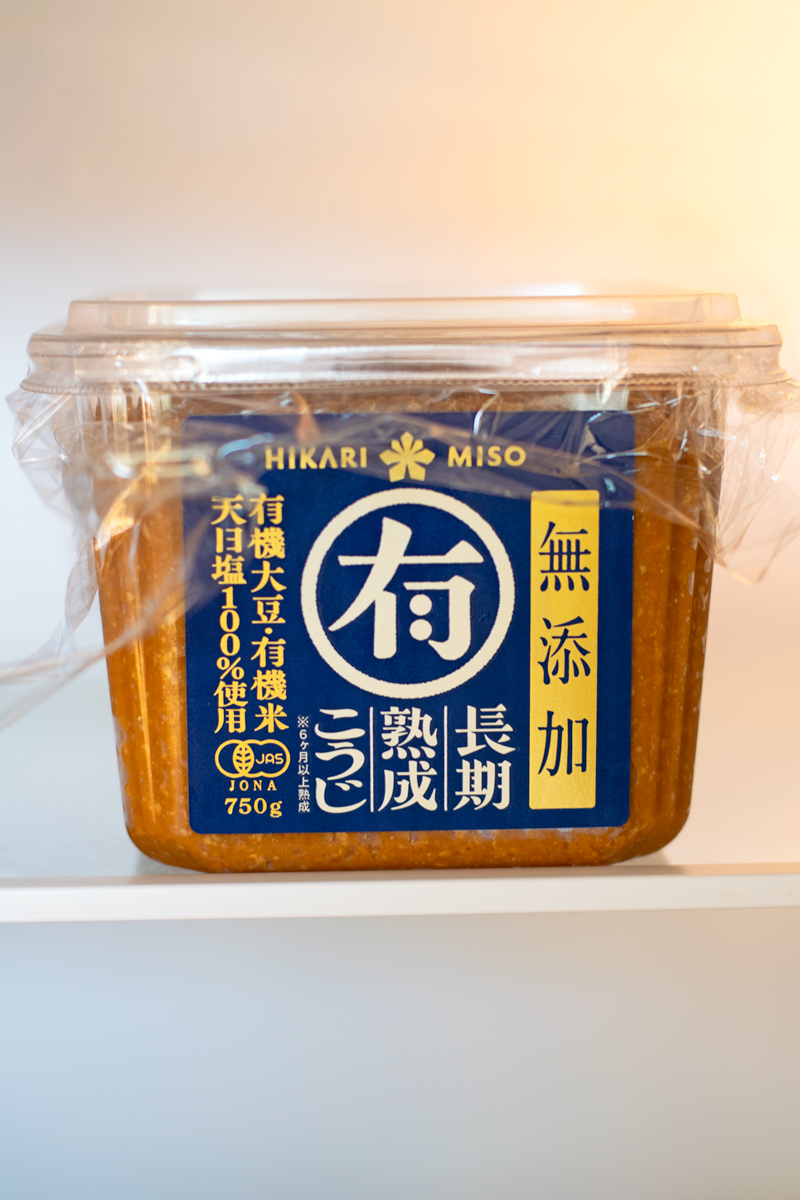From the bustling streets of Tokyo to the cozy kitchens of Kyoto, miso paste has been a sacred culinary secret passed down through generations.
But amidst the whispers of umami and whispers of tradition, a question lingers: how long does miso paste last?
Join us as we uncover the mysterious labyrinth of expiration dates and discover the hidden potential in every jar of miso paste.
how long does miso paste last
Miso paste can last beyond its expiration date but may lose some flavor.
The signs of spoiled miso include mold growth and changes in color.
Storing miso in a cool, dark place or the fridge is ideal for maintaining its quality.
You should use clean utensils to prevent contamination.
Miso paste can be frozen to extend its shelf life.
If there are signs of mold growth or an off odor, the miso should be discarded.
Trust your senses and taste buds when using expired miso.
Key Points:
- Miso paste can last beyond its expiration date, but may lose flavor.
- Signs of spoiled miso include mold growth and changes in color.
- Store miso in a cool, dark place or the fridge for best quality.
- Use clean utensils to prevent contamination.
- Miso paste can be frozen to extend its shelf life.
- If there are signs of mold growth or an off odor, discard the miso.
how long does miso paste last – Watch Video
💡
Pro Tips:
1. Miso paste, if stored properly, can last up to three years in the refrigerator, making it a long-lasting pantry staple.
2. The longer miso paste is fermented, the darker and richer in flavor it becomes. A longer fermentation process can take up to three years.
3. Did you know? Miso paste is made from fermented soybeans, rice/barley, salt, and a fungus called koji, which gives it its unique umami flavor.
4. Miso paste is not only used in savory dishes but can also be found in some delicious desserts, like miso caramel or miso-infused chocolate.
5. When stored in an airtight container in the freezer, miso paste can remain good for up to one year, allowing you to extend its shelf life and enjoy it for longer.
High Salt Content And Slow Spoilage
Miso paste is a traditional Japanese condiment made from fermented soybeans. It has a high salt content, which serves as a natural preservative. Unlike dairy and meat products, miso does not spoil rapidly. This is because the salt inhibits the growth of bacteria and other microorganisms that cause food spoilage.
The high salt content in miso paste not only helps in preserving it but also contributes to its unique flavor. The saltiness is a result of the fermentation process, where the soybeans’ natural sugars are converted into lactic acid. This fermentation process gives miso its rich umami flavor, making it a versatile ingredient in various dishes.
Expiration Date And Quality
While miso paste does come with an expiration date, it is important to note that this date primarily indicates when the miso is past its best quality. However, that does not necessarily mean it is unsafe to consume. Miso can still be safely eaten for a while longer after its expiration date if stored and handled properly.
It’s worth mentioning that the quality of the miso paste may deteriorate over time, resulting in a change in taste, texture, and color. Therefore, it is advisable to check the miso’s condition before use, especially if it has been stored past its expiration date.
Here are some important points to remember regarding miso paste:
- The expiration date indicates when the miso is past its best quality but doesn’t necessarily mean it’s unsafe to consume.
- Miso can still be safely eaten for a while longer if stored and handled properly.
- The quality of miso paste may deteriorate over time, leading to changes in taste, texture, and color.
- It is advisable to check the miso’s condition before use, especially if it has been stored past its expiration date.
“Miso paste, with its expiration date, primarily indicates best quality, but it can still be consumed safely if stored well.”
Signs Of Spoiled Miso
Miso paste is typically a smooth, homogeneous paste with a consistent color. However, if miso has spoiled, it may exhibit signs of deterioration. One evident sign is a change in color and the appearance of mold growth on the surface. If you notice any abnormal colors or see mold on the miso, it is a clear indication that the paste has gone bad and should be discarded.
Furthermore, temperature changes can affect the color of miso and potentially alter its flavor. Variations in temperature may cause the miso paste to darken, indicating a potential loss of quality. It is essential to store miso in a cool and dark place to maintain its optimal color and flavor.
Effect Of Temperature Changes
Temperature changes have a significant impact on the quality of miso paste. Fluctuating temperatures can result in a darker color and an altered flavor profile. Therefore, it is vital to protect miso from rapid temperature changes to prolong its shelf life.
For optimum preservation, it is recommended to store miso paste in a cool, dark place, away from direct sunlight and heat sources. Refrigeration is an excellent option as it helps to slow down the fermentation process and prevent spoilage. By storing miso in suitable conditions, you can preserve its taste and texture effectively.
Smell Test For Miso Quality
One of the best indicators of miso paste’s quality is its aroma. Good miso paste is expected to have a pleasantly salty and slightly sweet scent, reflecting the fermentation process that creates its complex flavors. On the other hand, bad miso paste emits a strong smell and has a sour taste, indicating that it has gone rancid and should not be consumed.
To ensure miso is still suitable for consumption, perform a smell test before use. Take a small amount of miso and observe its aroma. If it smells off or unpleasant, it is best to discard it to avoid any potential foodborne illnesses.
- Aroma is a key indicator of miso paste’s quality.
- Good miso paste should have a pleasantly salty and slightly sweet scent.
- Bad miso paste has a strong smell and sour taste, indicating it has gone rancid.
- Perform a smell test before using miso to check for any off or unpleasant odors.
- Discard miso if it smells off to prevent foodborne illnesses.
Ideal Storage Conditions
Proper storage conditions are crucial for extending the shelf life and maintaining the quality of miso paste. Storing miso in a cool, dark place is essential to prevent spoilage. An ideal storage location is a pantry or cupboard that is away from direct sunlight and heat sources.
-
To ensure optimal freshness, it is recommended to store unopened miso paste in the refrigerator. This not only helps preserve its quality but also ensures its safety for consumption.
-
After opening, transferring miso to an airtight container is highly recommended. This further helps to maintain the freshness of the paste.
-
Labeling the container with the date of opening is also important, as it allows for better tracking of the miso paste’s freshness.
Remember, proper storage conditions are key to extending the shelf life and preserving the quality of miso paste.
- Store miso in a cool, dark place
- Use an airtight container after opening
- Label the container with the date of opening.
Contamination And Bad Miso
Contamination can easily spoil miso. To ensure the longevity of the miso paste, always use clean utensils when scooping the paste out of the container. Avoid introducing foreign particles like bread crumbs or other food residue, as they can lead to mold growth or the presence of harmful bacteria.
Furthermore, storing miso paste in a contaminated environment can accelerate spoilage. It is recommended to keep strongly smelling foods such as onions or garlic away from the miso paste, as their odors can transfer and impact the flavor. To prevent cross-contamination, it is best to store miso in a separate compartment in the refrigerator, away from strongly smelling foods.
Freezing Miso Paste
If you have leftover miso paste that you won’t be able to use before it expires, freezing is a great way to prolong its shelf life without affecting its texture or taste.
To freeze miso paste:
- Transfer small portions into airtight containers or freezer bags.
- Ensure the containers are sealed properly to prevent freezer burn and maintain the quality of the paste.
When you want to use the frozen miso, simply thaw it in the refrigerator overnight before adding it to your recipes.
Packaging And Shelf Life
The packaging of miso paste is crucial in determining its shelf life. To protect the miso from air and moisture, airtight containers are necessary. It is recommended to use glass jars or ceramic containers with tight-fitting lids for storing miso paste.
Plastic containers, on the other hand, should be used with caution. Certain types of plastic can affect the taste and quality of miso over time. If opting for plastic containers for temporary storage, it is important to ensure that they are food-grade and tightly sealed.
It is important to note that miso paste can be stored beyond its labeled expiration date if it shows no signs of spoilage. However, for the best taste and quality, it is generally recommended to use miso paste within a few months.
- Airtight containers are essential to protect miso paste from spoilage due to air and moisture.
- Glass jars or ceramic containers with tight-fitting lids are recommended for storage.
- When using plastic containers, be cautious of their potential effects on taste and quality.
- Food-grade and tightly sealed plastic containers are suitable for temporary storage.
- Miso paste can be stored beyond its expiration date if it remains free of spoilage indicators.
Storing Unopened Miso Paste
To maximize the shelf life of unopened miso paste, it is important to store it properly. If the package remains unopened, it can be stored in a pantry, as long as the area is cool, dry, and away from direct sunlight. However, it is important to note that refrigeration is the best option for storing unopened miso paste, as it provides optimal temperature control and extends the paste’s freshness.
Freezing unopened miso paste is also an excellent way to prolong its shelf life. The cold temperature prevents the aging process and maintains the paste’s quality for an extended period. Simply transfer the unopened miso paste into a freezer-safe container and store it in the freezer until needed.
💡
You may need to know these questions about how long does miso paste last
How do you know if miso has gone bad?
To determine if miso has gone bad, one can look for several indicators. Firstly, if the color of the miso appears darker than it was initially, it may indicate spoilage. Another sign is a sour taste, suggesting that fermentation has occurred for an extended period. Additionally, the presence of white fluffy mold is a common occurrence on miso paste and can suggest spoilage. Lastly, a bad smell could also be an indication that the miso has gone bad.
Does miso paste ever expire?
Miso paste does not technically expire, thanks to its high salt content. As a preservative food, it can be stored in the refrigerator for a considerable amount of time without going bad. However, while it may still be safe to consume after a year, the overall quality of taste may gradually decline. Therefore, for the best flavor, it is recommended to use miso within a year of purchasing it.
How do you store miso paste after opening?
To properly store miso paste after opening, it is crucial to transfer it into an airtight container and place it in the refrigerator. By doing so, you can effectively slow down the degradation process and prolong its usability. Remember to always use clean utensils when scooping out the paste to ensure its freshness and prevent any potential contamination.
Does miso paste go in the fridge after opening?
Yes, it is recommended to store miso paste in the fridge after opening. By keeping it in an airtight container and refrigerated, you can ensure that its freshness and quality are preserved. Storing miso at room temperature can cause it to lose its taste quickly. Therefore, it is best to keep it in the fridge where it can last for a year or even longer.
Reference source
https://knifeandsoul.com/how-long-does-miso-last-in-the-fridge/
https://chefjacooks.com/en/does-miso-paste-go-bad/
https://hikarimiso.com/faqs/
https://www.savorysuitcase.com/how-to-store-miso/



